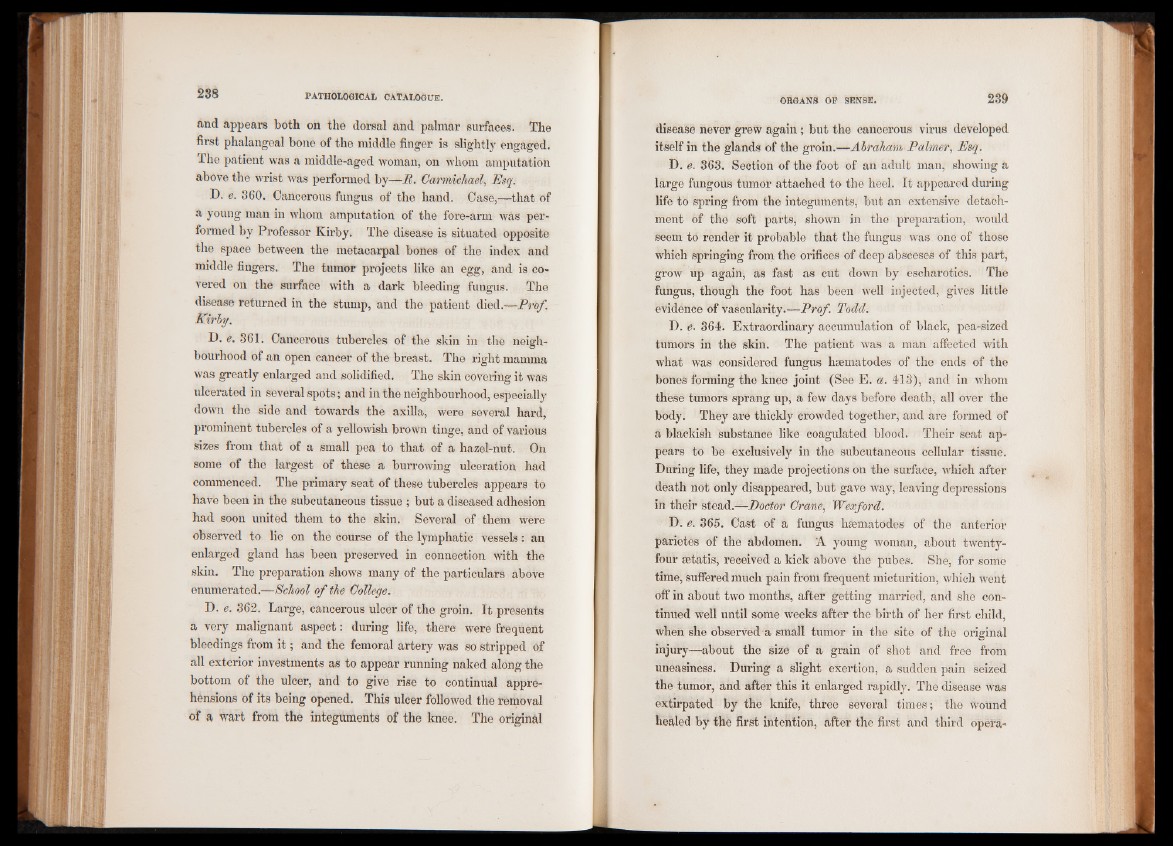
and appears both on the dorsal and palmar surfaces. The
first phalangeal bone of the middle finger is slightly engaged.
The patient was a middle-aged woman, on whom amputation
above the wrist was performed by—B. Carmichael, Esq.
D. e. 360. Cancerous fungus of the hand. Case,—that of
a young man in whom amputation of the fore-arm was performed
by Professor Kirby. The disease is situated opposite
the space between the metacarpal bones of the index and
middle fingers. The tumor projects like an egg, and is covered
on the surface with a dark bleeding fungus. The
disease returned in the stump, and the patient died.—Prof.
Kirby.
D. e. 361. Cancerous tubercles of the skin in the neighbourhood
of an open cancer of the breast. The right mamma,
was greatly enlarged and solidified. The skin covering it was
idcerated in several spots; and in the neighbourhood, especially
down the side and towards the axilla, were several hard,
prominent tubercles of a yellowish brown tinge, and of various
sizes from that of a small pea to that of a hazel-nut. On
some of the largest of these a burrowing ulceration had
commenced. The primary seat of these tubercles appears to
have been in the subcutaneous tissue ; but a diseased adhesion
had soon united them to the skin. Several of them were
observed to lie on the course of the lymphatic vessels: an
enlarged gland has been preserved in connection with the
skin. The preparation shows many of the particulars above
enumerated.—School of the College.
D. e. 362. Large, cancerous ulcer of the groin. It presents
a very malignant aspect: during life, there were frequent
bleedings from it ; and the femoral artery was so stripped Of
all exterior investments as to appear running naked along the
bottom of the ulcer, ahd to give rise to continual apprehensions
of its being opened. This ulcer followed the removal
of a wart from the integuments of the knee. The original
disease never grew again; but the cancerous virus developed
itself in the glands of the groin.—Abraham Palmer, Esq.
D. e. 363. Section of the foot of an adult man, showing a
large fungous tumor attached to the heel. It appeared during
life to spring from the integuments, but an extensive detachment
of the soft parts, shown in the preparation, would
seem to render it probable that the fungus was one of those
which springing from the orifices of deep absceses of this part,
grow up again, as fast as cut down by escharotics. The
fungus, though the foot has been well injected, gives little
evidence of vascularity.—Prof. Todd.
D. e. 364. Extraordinary accumulation of black, pea-sized
tumors in the skin. The patient was a man affected with
what was considered fungus hsematodes of the ends of the
bones forming the knee joint (See E. a. 413), and in whom
these tumors sprang up, a few days before death, all over the
body. They are thickly crowded together, and are formed of
a blackish substance like coagulated blood. Their seat appears
to be exclusively in the subcutaneous cellular tissue.
During life, they made projections on the surface, which after
death not only disappeared, but gave way, leaving depressions
in their stead.—Doctor Crane, Wexford.
D. e. 365. Oast of a fungus hsematodes of the anterior
parietes of the abdomen. A young woman, about twenty-
four setatis, received a kick above the pubes. She, for some
time, suffered much pain from frequent micturition, which went
off in about two months, after getting married, and she continued
well until some wTeeks after the birth of her first child,
when she observed a small tumor in the site of the original
injury—about the size of a grain of shot and free from
uneasiness. During a slight exertion, a sudden pain seized
the tumor, and after this it enlarged rapidly. The disease was
extirpated by the knife, three several times; the Wound
healed by the first intention, after the first and third opera